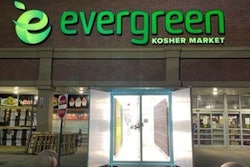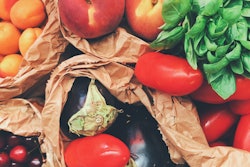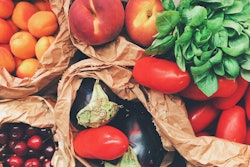
The Coronavirus disease (COVID-19) pandemic revealed a hard truth—years of optimizing food supply chains for cost have left them lean, but brittle.
Food producers and processors following the dictates of lean manufacturing have narrowly tailored their production lines, outgoing inspections and capital equipment to the needs of specific buyers. And, widespread consolidation has left a handful of companies controlling production and distribution in many major food categories.
These strategies cut costs in the short term, but leave suppliers unable to adapt when demand shifts or other links in the chain break. That’s why in April farmers ended up burying surplus crops and pouring out gallons of milk even as grocery store shelves stood empty. It’s also why we suffered shortages of meat when the four companies that process 85% of America’s beef shut down a few meatpacking plants. Our food supply chains are too fragile to cope with crises.
An inadequate solution
In May, President Trump announced $19 billion in aid to compensate farmers for losses associated with COVID-19. His stated aim is to “maintain the health of the food supply chain” in the face of disruption due to the pandemic.
However, simply giving monetary aid to farmers won’t be enough to secure the food supply. Instead, we need to change how our supply chains are structured. Every raw material should have multiple paths to market, with producers able to switch between paths as needed to use up surpluses and avoid shortages. Supply chains should also be circular, with unused or surplus produce fed back into the system for recycling, reprocessing and reuse.
These changes will require the food industry to shift away from lean manufacturing principles to embrace the value of flexibility, modularity and resiliency. They will also require mass digitization to enable real-time, AI-driven analysis of product flows and other relevant data. The tools are all there — now it’s just up to us to use them.
Giving your supply chain a “digital twin”
When it comes to building a more resilient future, one thing holds us back—a lack of visibility into the intricacies of the food supply chain. In buyers’ relentless search for the lowest possible cost, chains have expanded rapidly — there were 9.5 million transfers of food between U.S. counties in 2012, the only year for which the data has been fully mapped.
This complex web of transactions is the product of dozens of individual decisions by buyers and suppliers who can’t see the bigger picture and may not have visibility beyond the next link in the chain. Many transfers are circuitous: For example, in 2012 one shipment of corn harvested in Illinois traveled to two other Midwestern states for processing before returning back to Illinois in animal products intended for grocery store shelves.
Today’s supply chains are “linear,” but really they’re more complicated than that. Supply chains are ecosystems of buyers, suppliers, service providers, multi-tier original equipment manufacturers (OEMs) and IT systems. To accomplish the kind of real-time rerouting that’s key to more flexible, circular supply chains, we will first of all need visibility into every interaction within these intricate webs — not just handoffs between buyers and sellers, but also events like inspections, certifications and payments.
Using the Internet of Things (IoT) and other technology, a fully connected supply chain will collect data at every step, creating a “digital twin” of the physical product journey. Payments should be fully digitized to also allow the tracking of cash flow through the system.
Enabling flexibility and circularity
With more visibility into what’s happening at every step in the process, it’s easier to see the benefits of building out multiple supply chains and switching between them at will. When demand suddenly shifts or a supplier further down the chain is unable to deliver, companies can seamlessly pivot to another chain, leaving production and cash flow uninterrupted. Optimizing across the entire ecosystem in this way will also unlock time and cost savings. You may no longer have to choose between low prices and flexibility.
Companies will also start identifying opportunities to recycle or reprocess used or leftover products by feeding them back into the supply chain. This circularity enables the chain to capture the full value of its output — much of which is currently lost in the ecosystem. According to the USDA, 30-40% of all food produced in the United States is wasted across all links in the chain.
They will also unlock substantial value by finding uses for that lost production. That could mean repackaging or remanufacturing the original product for a new end client, reusing material in a higher value product or recycling used material. For example, food waste can be recycled as animal feed, or composted and sent back to farmers to fertilize their crops. Collaborating with your suppliers and customers, you could open entire new marketplaces for recycled, reused and repurposed goods.
The United States and other wealthy nations almost never experience true food shortages; we just have food distribution problems (as experienced with COVID-19). With a more flexible system, shutting down a few meat processing plants wouldn’t keep people from eating burgers because ranchers could easily find somewhere else to sell their cattle. And, if restaurants and office cafeterias closed, farmers would just send their produce somewhere else. If we can manage to make these improvements, our food supply chain will weather the next crisis much better.
A more resilient future
Governments around the world have a vested interest in ensuring grocery store shelves are well stocked, especially in times of crisis. If they want to strengthen food supply chains, they should go beyond offering short-term aid and instead foster transparency, flexibility and circularity for the long term.
That could mean offering tax breaks and other incentives for companies looking to build connectivity within the food ecosystem or improve recycling and refurbishing programs. Or it could mean mandating the labeling of a food’s provenance on its packaging, similar to how we have nutrition labels today. A more transparent supply chain is a more flexible one, and in turn a more resilient one. However governments go about it, this is the future they should help create.


















